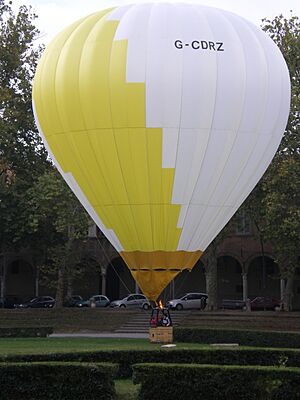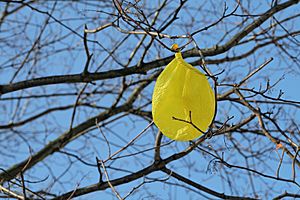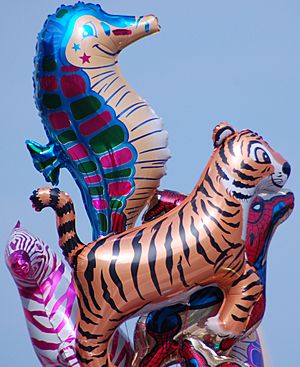Balloon facts for kids
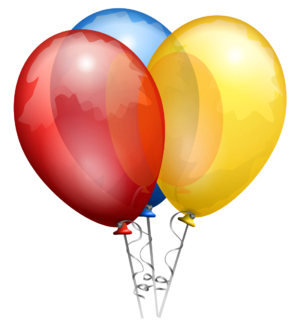
A balloon is like a flexible bag, usually filled with gas. This gas can be helium, hydrogen, or even just regular air.
Long ago, balloons were made from animal bladders. Today, small balloons are made from thin, stretchy materials like rubber or plastic. Bigger balloons, like those used for flying, are made from fabric.
Balloons are used for many different things.
Most small balloons are made for parties. Some are even shaped like animals!
Some balloons are very big. These huge balloons can carry people into the sky. Big balloons that fly are called aircraft. Most of these are filled with hot air and are known as hot air balloons.
Balloons can also be filled with water. These are called "water balloons" and are often used as toys.
The rubber balloon was first invented by Michael Faraday in 1824. He created it while doing experiments with different gases.
Contents
How Balloons Are Used
For Fun and Decorating
Balloons are popular for decorating parties, weddings, school events, and other celebrations. People who create designs with round balloons are called "stackers." Those who use long, thin balloons to make shapes are called "twisters."
While helium balloons are common for decorating, many decorators now use air-filled balloons. This is because helium is a natural resource with a limited supply. Common balloon decorations include arches, columns, centerpieces, and balloon bouquets.
Twisting balloons can be used to make unique decorations or figures for events. These are often called "party balloons." Artists twist and tie these balloons to create fun shapes and characters.
You can fill a balloon with air using your mouth, a hand pump, or a machine that provides compressed gas.
Rubber or plastic balloons filled with helium usually float for about a day or so. Even a perfect rubber balloon slowly loses gas. This happens because gas particles slowly move through the balloon's material, a process called diffusion.
Since the late 1970s, more expensive foil balloons have become popular. These are made from thin, shiny materials like Mylar. They often have colorful pictures and patterns. Foil balloons are lightweight and can keep helium gas from escaping for several weeks. However, foil balloons have sometimes caused problems if they touch power lines.
Balloon Art and Sculptures
Balloon modelling artists are entertainers who twist and tie inflated balloons into amazing sculptures. The balloons used for these sculptures are made of extra-stretchy rubber. This allows them to be twisted and tied without popping. These special balloons are often hard to inflate by mouth, so artists usually use a pump.
Balloon Drops and Releases

Balloons are often used for "balloon drops." This is when a large net or bag filled with air-filled balloons is hung high up. When released, the balloons fall down onto a crowd below. Balloon drops are common at New Year's Eve parties, rallies, and graduations.
Balloons for Advertising
Balloons are also used to advertise at big events. Companies can print their designs and logos onto balloons using a special process called Screen printing. Machines inflate the balloon and apply ink with elastic qualities through a silk screen.
Water Balloons
Water balloons are small, thin rubber balloons filled with water instead of gas. They are designed to break easily. Kids often throw them at each other as a fun game or practical joke. You can also squeeze water out of an open water balloon to use it like a small water gun.
Solar Balloons
Solar balloons are large, thin balloons filled with air. The sun heats the air inside, making it lighter than the air outside. This causes the balloon to lift and float.
Balloon Rockets
You can create a "balloon rocket" by letting go of an inflated balloon. This works because the stretchy balloon squeezes the air inside. When the opening is released, the air rushes out. According to Newton's third law of motion, this pushes the balloon forward, just like a real rocket!
Balloons as Flying Machines
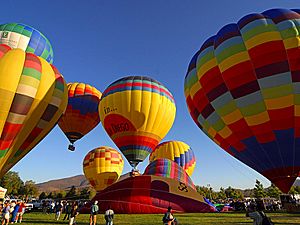
Since the 1700s, balloons filled with hot air or light gas have been used to fly. The first flights used hot air balloons, which had air heated by a flame, or balloons filled with hydrogen gas. Later, coal gas and then helium were used. A balloon without an engine just floats with the wind. A balloon with an engine to steer it is called an airship.
Balloons in Medicine
Very small balloons are used in some medical procedures. For example, in a procedure called Angioplasty, tiny balloons are put into blood vessels near the heart. The balloon is inflated to clear blockages and stretch the vessel walls. This helps prevent heart attacks. A small stent (a tiny tube) can be left behind to keep the vessel open.
Balloon catheters are tubes with a balloon at their tip. This balloon can be inflated to keep the catheter in place. For example, a Foley catheter has a balloon that is inflated in the bladder to secure it.
Balloons filled with air or liquid can also be used inside the body to help stop bleeding in organs like the stomach.
Images for kids
-
Decorative rainbow colored arches made of party balloons used at the gay pride parade in São Paulo, Brazil.
-
Contemporary illustration of the first flight by Professor Jacques Charles, December 1, 1783


